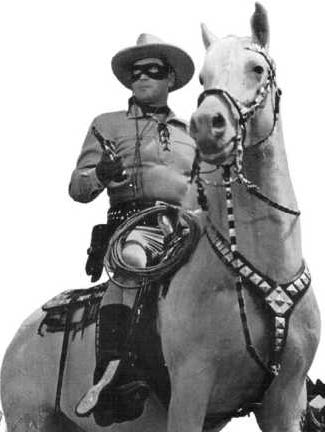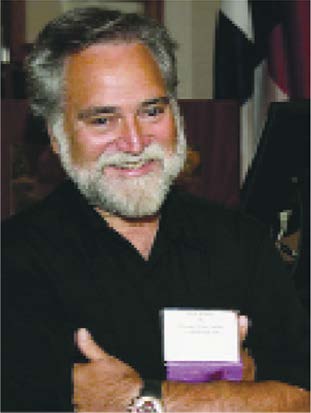ANCORA IMPARO
RICK RADER, MD ■ EDITOR-IN-CHIEF
Who Was that Masked Man? People with intellectual and developmental disabilities respond to non-verbal communication; case in point is "the smile," which serves to comfort, reassure, invite, include and announce peace, tranquility and acceptance. The face mask does not allow that announcement to take place.
Growing up in Brooklyn in the 1950's was the inspiration for my brother and me to become cowboys. We weren't alone. There were millions of kids who wanted to live on a ranch, ride horses, go on round ups, drink coffee from tin cups, eat our meals from the chuck wagon and of course, if necessary, have shoot-outs with rustlers. Our imagination was fueled with Saturday morning cowboy TV shows and cowboy movies. We were glued to the TV watching endless episodes of Roy Rogers, Gene Autry, The Rifleman, Laramie, Wyatt Earp, Hopalong Cassidy, Cheyenne and The Range Rider. My favorite was The Lone Ranger.
While the Lone Ranger had all the requisite skills of all the TV cowboys (riding, shooting, high morals and ethics and good looks) there was one distinguishing, novel and unique aspect to his persona. He wore a mask.
Why would a good guy wear a mask? The story goes that he was the last surviving Texas Ranger from an ambush. He was nursed back to health by an Indian named Tonto, who became his trusted sidekick. The Ranger recovers and decides to take up a secret identify to track down and bring to justice bad guys. He dons a black mask and a white hat, calling himself "The Lone Ranger." It wasn't your typical Western mask which was a bandana covering the entire face up to the bottom of the eyes; that was the bad guys mask. The Lone Ranger's mask only covered his eyes. This came in handy when he needed to show young cowpokes like myself how facial expressions could convey whether you were a good guy or a bad guy, whether you were telling the truth or lying.
The Lone Ranger was played by an actor named Clayton Moore from 1953 to 1957. While he had other acting roles during his career, he was best known as The Lone Ranger. As Moore aged, there were fewer acting offers and he was able to eke out a living doing personal appearances, wearing his mask and signing autographs as The Lone Ranger. The owner of the Lone Ranger character obtained a court order prohibiting Moore from making future appearances as the Lone Ranger and from wearing the "mask."

HI-YO SILVER, AWAY!: Clayton Moore's mask was part of one of the most iconic costumes in the history of American television. It is now on display at the Smithsonian Museum of American History.
The public loved Moore and was appalled by the legal battle. Moore was then 65 years old and was hardly a threat to any new revival of the character. Moore continued to make personal appearances, but instead of donning his distinguished mask, he wore wraparound sunglasses. The public knew he was their beloved Lone Ranger. The image of the "masked man" and its importance kept the legal battles going for over 25 years. The lawsuit was eventually dropped and Moore continued to appear with his "mask" and as The Lone Ranger until his death in 1999. He was so strongly identified as the "Masked Man" that he is the only person on the Hollywood Walk of Fame to have his character's name along with his on the star, which reads, "Clayton Moore – The Lone Ranger."
The name "face mask" reflects the purpose of the device, to hide the features of the face or to portray something so frightening that it can also serve as a deterrent to approaching, interacting, or confronting the wearer. To inhabitants of certain parts of India and Bangladesh, they have literally become "two faced". For years there have been scores of individuals being killed by tigers that have been living under protection in a reserve in the Ganges Delta in India. With the realization that tigers only attack people from behind, workers in the mangrove forests started wearing face masks on the backs of their heads. The experiment worked effectively until the tigers caught on to the hoax. Bethany Foster reminds us that "Masks have been worn in nearly all cultures, for various reasons, since the Stone Age. Masks have been worn as a form of disguise, by an actor in a performance, as part of a religious ceremony, as part of membership in a secret society, as punishment for a criminal or in celebration of a holiday."
When I finish the draft of this editorial, I will command it to print out a copy on the machine located outside of my office in the Habilitation Center at Orange Grove. I will become a "masked man" before I leave my office. It's not to use as a disguise, or to prevent frontal attacks from tigers, but in com pliance to our strict policies during the current COVID-19 virus pandemic.
In the late 1800's, as the Germ Theory spread, the use of masks to prevent disease becomes more prevalent and recommended. In 1878, Dr. A. J. Jessup writing in the Hospital Gazette, recommended cotton masks to limit contagion during epidemics. "Thus we see that as quarantine and disinfection will certainly spread of contagion from patient to patient, may we not confidently hope, by preventing the entrance of germs into the lungs and blood, by a properly constructed filtering mask to yet witness the spectacle of a population walking about the streets of a cholera infested city, without fear of its infection however deadly. As a properly made cotton filter worn over the mouth and nose must shut out all atmospheric germs of the ordinary putrefactive kind. We may confidently assured that those of daises will be equally excluded."
While the use of face masks is rooted in epidemiological best practices and is endorsed by legions of respected virologists, infectious disease specialists, and public health officials, it has had an unanticipated consequence for people with intellectual and developmental disabilities. This population, like most individuals, respond to non-verbal communication; case in point is "the smile". The smile serves to comfort, reassure, invite, include and announce peace, tranquility and acceptance. The face mask does not allow that announcement to take place. They cannot see you smile; but can assume you are not smiling. In addition, the volume and the tonality of the voice is also typically associated with a smile. Wearing a face mask can also dilute, derail and dismiss the reassurance of a polite tone. The use of face masks in concert with social distancing had made it much more difficulty for us to effectively communicate, understand and interact with each other.
We are finding it more and more difficult "Appreciate that, for some of us, it will always appear that you still have a face mask on." to "read each other." Dr. Patrick Wanis, a human behavior expert explains, "Your ability to sense your friend's sadness is due to mirror neurons, which mirror within you the act or feeling that the other person is experiencing. And the reason you can mirror that feeling is because you can read it in their facial expressions When half your face is covered, that's infinitely more difficult to do."
Perhaps there is a silver lining in the widespread adoption of wearing a face mask. Many individuals with autism and related disorders are typically unable to "read" faces, even when there are no face masks to disrupt the flow of mirror neurons. As face mask–wearing "neuro-typicals" are second guessing their ability to read emotions and to respond to the new onslaught of confusing social expectations, it hopefully will serve as a strong lesson when we are free from wearing face masks. But appreciate that, for some of us, it will always appear that you still have them on. For our individuals living in the "spectrum community," there will always be the concern that they are wondering who is that "masked man." •

ANCORA IMPARO
In his 87th year, the artist Michelangelo (1475 -1564) is believed to have said "Ancora imparo" (I am still learning). Hence, the name for my monthly observations and comments. – Rick Rader, MD, Editor-in-Chief, EP Magazine Director, Morton J. Kent Habilitation Center Orange Grove Center, Chattanooga, TN